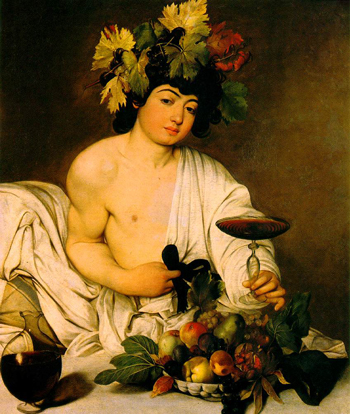
Bacchus

|
Bacchus
Bacchus was painted by Caravaggio (Michelangelo Merisi) shortly after he arrived in Rome in 1589. It is one of the finest paintings of his early career, a career that stood largely in opposition to court painting and the great 16th-Century painting tradition, as exemplified by the likes of Caracci and his contemporaries.
In Bacchus, Caravaggio treats the subject with remarkable simplicity: the painting is rather light on detail, instead focusing on the form and provocative, playful gaze expression of the Roman god. On Bacchus's head is a garland of vine-leaves, and in his hands are a crystal-clear bottle of wine and a calyx, a nod to his status as the god of wine (among other things). His figure is simultaneously soft, supple, and muscular, with a pure, mellow light playing over his smooth flesh. The result is a radiant, beautiful male figure, one of the hallmarks of Italian Renaissance art.
The juxtaposition of this mythic figure with a mood and setting that evoke commonality is actually typical of Caravaggio's work: his favorite subject was that of the sacred or mythic story, transposed to an everyday environment and presentation. Neither Bacchus himself nor the objects about him connote an especially divine quality--indeed, he seems to be extending the calyx to us, mortals, in an invitation to join him. In its day, this was a revolutionary concept, and made Caravaggio literally peerless in his day.












